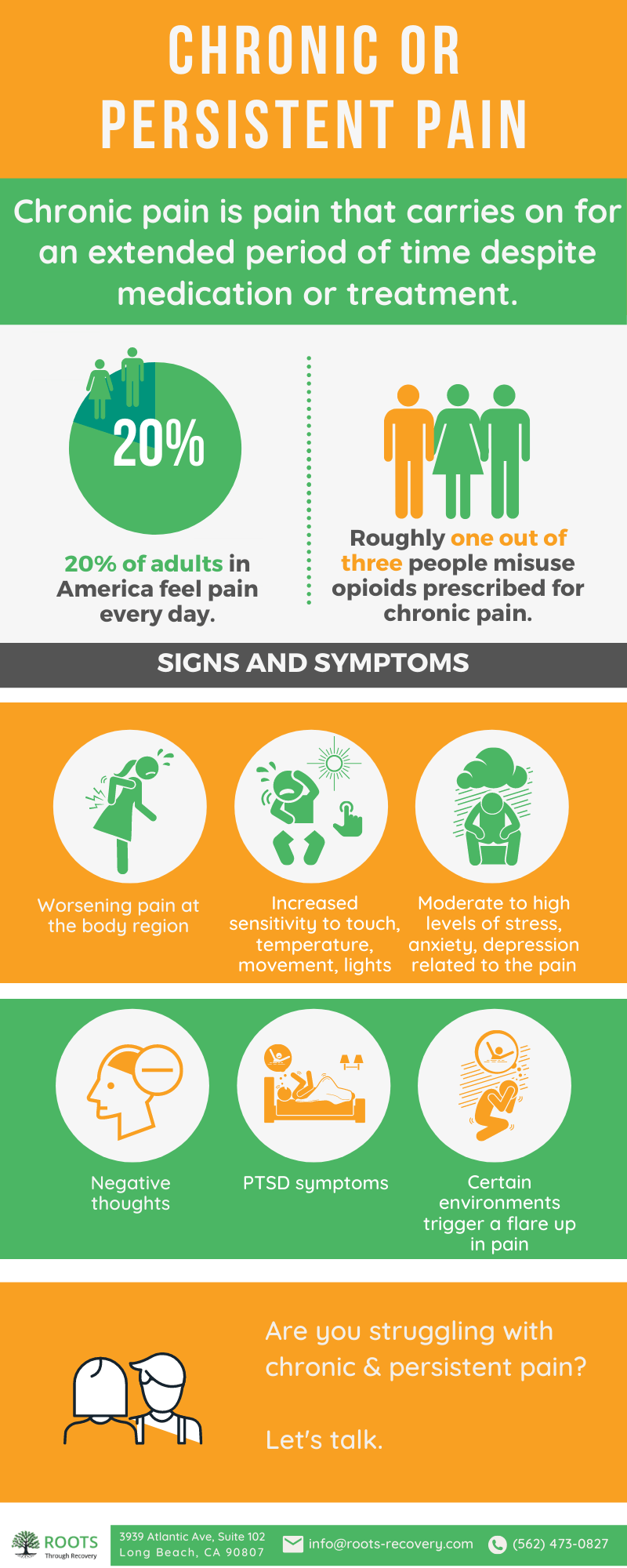
Chronic & Persistent Pain
Pain is very real and can be complex. Chronic/Persistent pain has been misunderstood and mistreated for a very long time, with a focus purely on single body regions, excessive medical imaging and testing, and an overuse of medications, injections, surgery, and passive therapies as a primary form of treatment. This has resulted in many people not getting the care they need, feeling lost, abandoned and their suffering not believed. At Roots, we start with the affirming statement of “All pain is real”, and understand that everyone experiences pain in different ways depending on their beliefs about pain. These beliefs are shaped by a multitude of factors, from cultural norms to past treatment to family or work-related stress.
Whatever your beliefs or pain experience are, Chronic or Persistent Pain can interfere with your daily life and can keep you from doing things you want and need to do. If your pain has led to dependence on prescription pills, alcohol or other drugs, or is taking a toll on your self-esteem or making you feel angry, depressed, anxious or frustrated, this is a good indicator to seek help. Additionally, we offer a free assessment test that one can take.
What is it?
Chronic pain is pain that carries on for an extended period of time despite medication or treatment. For many people, chronic pain starts after an injury, operation or because of a health condition. But sometimes, pain can also begin without any obvious cause and can come on for those without any history of an injury or operation. Here’s a list of common chronic pains:
- Low Back Pain
- Failed Low Back Surgery Syndrome
- Sciatica
- Neck Pain
- Neuropathies and Neuralgias
- Cervical and Lumbar Radiculopathies
- Complex Regional Pain Syndrome (CRPS)
- Opioid-induced Hyperalgesia
- Irritable Bowel Syndrome
- Headaches (Cervicogenic, Tension Type, and Migraine)
- Pelvic Pain Conditions (Chronic Prostatitis/Pelvic Pain Syndrome, Pudendal neuralgia, Vaginismus, Vestibulodynia, Vulvodynia, Chronic Postpartum Pain, Chronic Pelvic Pain Post-Gender Affirmation Surgery)
- Fibromyalgia
What are the signs and symptoms?
Worsening pain at the body region originally affected
Other body regions or the entire body becoming painful as well
Increased sensitivity to touch. For example, forms of touch, such as a light brush to the skin are uncomfortable or painful
Increased sensitivity to temperature. For example, cold temperatures aggravate your pain
Increased sensitivity to movement. It takes minimal movement to aggravate your pain severely.
Increased sensitivity to lights, noise, smells, and/or food
Experiencing consistently moderate to high levels of stress, anxiety, and depression related to the pain
Negative thoughts tend to overcome your mind
Post-traumatic stress disorder (PTSD) symptoms aggravate your pain
Certain environments trigger a flare up in pain. For example, increased pain when sitting in a car, after a car accident.
FAQs
Q: What is the difference between acute pain and chronic pain?
A: Acute pain can be mild and last a short period of time, or be severe and last for weeks or months, but is followed by healing. Chronic pain is pain that is ongoing and lasts longer than a few months.
Q: What is pain?
A: Pain is the brain's interpretation of information from an alarm system formed by the brain and the nerves inside the spine that make up the central nervous system. One can usually expect pain to settle down with time, but sometimes the brain continues sending out pain signals that are hard to stop. Some of these signals may come for no obvious reason, but it doesn't make pain any less real.
Q: Do opiates cause more pain?
A: Opiates do provide temporary relief by blocking pain. But the body will then adjust and increase pain receptors to get the signal through to the brain, so when the drug wears off, the person will end up experiencing more pain.
Take the First Step Now
If you need to find a place that feels comfortable and supportive, let Roots Through Recovery’s experienced clinicians and case management team work with you to help determine your next steps. We want you to have choices that will give you and your loved ones the best outcomes.



